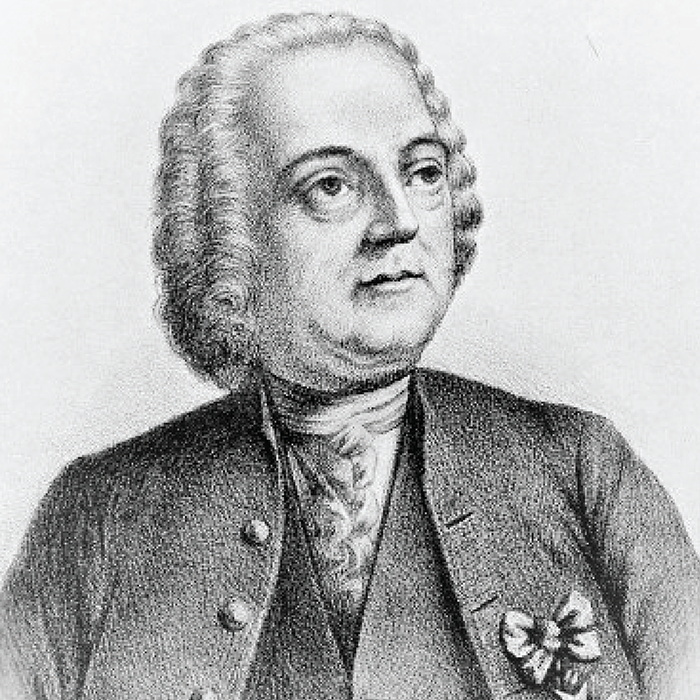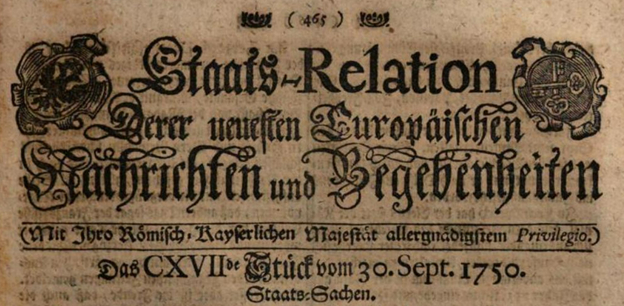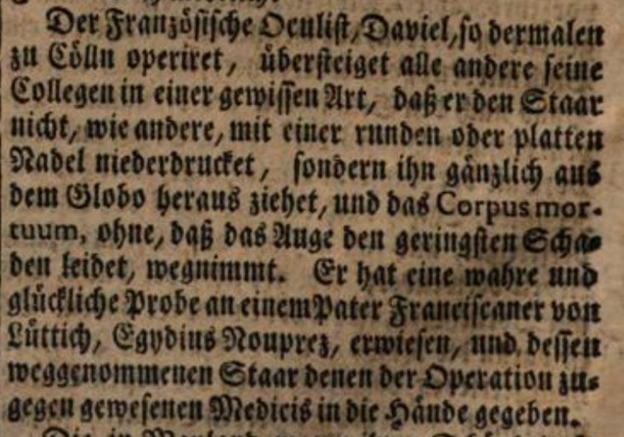
Credit: Jacques Daviel by Wellcome Library, London / CC BY
Couching, defined as displacing the opacified crystalline lens into the vitreous, was the first documented form of cataract surgery – and relied upon for many centuries. Jacques Daviel of France formally presented planned primary cataract extraction of the opacified lens from the posterior chamber in 1752 (1). But when did Daviel first perform this procedure – and was he the first? The literature suggests the date was between 1745 and 1752.
Daviel’s letters and advertisements of September 1748, and February and July 1749 confirm that, up to that time, he had been performing couching, with one exception (2). Some time before September 1748, Daviel attempted a couching on M. Garion, a master wig-maker, and then secondarily incised the cornea and introduced a needle (“aiguille”) to remove the cataract (or fragments thereof) from the posterior chamber (1-3). Daviel’s unpublished log, discovered in 2004, confirms that in 1746, 1747, 1748, and the first half of 1749, he performed no cataract extractions, except for the Garion case (3).
Daviel never publicly claimed to have performed cataract extractions in the towns in which he practiced in the latter half of 1749 and the first half of 1750: Paris, Auxerres, Péronne, Cambrai, and Douai (2). Reports from Cambrai in May 1750 and Liège in July and August 1750 laud Daviel without hinting at a revolutionary new cataract procedure (2).
In 2023, we identified newspaper clippings from Regensburg describing Daviel’s ophthalmic tour, including a notice from September 30, 1750 (see Figures 1 and 2):
In translation:
“The French oculist, Daviel, who is currently operating in Cölln, surpasses all of his colleagues in a certain way that he does not press down the cataracts with a round or flat needle like others do, but pulls them completely out of the globe, and takes away that corpus mortuum without the eye suffering the slightest damage. He proved a true and happy trial on a Franciscan Father of Liège, Egydius [Gilles] Nouprez, and put his cataract into the hands of the doctors who were present at the operation.”
Daviel’s log confirms that he performed the cataract extraction on Gilles Nouprez on September 18, 1750 in Cologne (3). Daviel wrote about this case in 1752: “One that I did at Cologne on a ‘Religieux’ was an even more striking success as the cataract was soft like jelly. However, the ‘Religieux’ was in a state to say the Mass 15 days after the operation” (1).
Daviel subsequently performed planned primary cataract extractions in three patients in Mannheim in October and November 1750, as confirmed by the newspapers, and by a letter written by his surgical colleague Vermale (1-3).
In September 1751, Natale Pallucci, an Italian surgeon who practiced in Paris at the same hospital as Daviel, claimed that Daviel’s procedure was not new, as evidenced by the fact that he (Pallucci) had performed secondary extraction of cataract fragments from the posterior chamber on July 3, 1750 following a failed couching (2). Daviel responded in 1752 that he had actually been performing cataract extractions occasionally since 1745 without telling anyone (1-3). However, Daviel’s accounts lacked specifics and were self-contradictory (1).
Thus, the first planned, primary cataract extraction that can be documented was performed by Jacques Daviel in Cologne on September 18, 1750. Claims by Daviel, Pallucci, John Taylor of England, or others to have performed the procedure before this time have not been verified.

Figure 1 (Credit: Wellcome Library, London / CC BY)

Figure 2 (Credit: Wellcome Library, London / CC BY)
References
- JA Daviel JA, WG Pearce WG (trans.), “On a new method to cure cataract by extraction of the lens by Jacques Daviel,” translated by WG Pearce. Brit. J. Ophthalmol., 51, 449 (1967).
- CT Leffler et al., The First Planned Cataract Extraction from the Posterior Chamber by Delivery of the Lens Which Jacques Daviel Documented was Performed on September 18, 1750. Presented at the Cogan Ophthalmic History Society. Sacramento, CA. September 8, 2023.
- L André L, J Daviel, “Liste des Malades a qui J’ai Fait l’extraction de la Cataracte de la Chambre Postérieure de l’oeil par la nouvelle methode que j’ay inventé a Marseille depuis 1745.” Manuscrit inédit de Jacques Daviel. Par le Médecin Général Inspecteur Louis André. Communication à la Société Francophon’ d’Histoire d’ l’Ophtalmologie. Le 8 mai 2004 à Paris France. Provence historique: Revue Trimestrielle. 2005: 421-433. Available from: https://www.snof.org/encyclopedie/un-manuscrit-in%C3%A9dit-de-daviel Accessed June 1, 2023.
